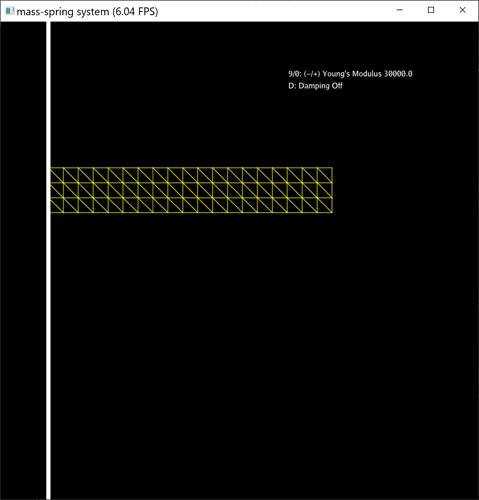我修改成GGUI之后,报错
Exception: unrecognized event tag
GLFW Error 65537: The GLFW library is not initialized
详细 log 如下
C:\ProgramData\Anaconda3\envs\taichi_learn\python.exe D:/PycharmProjects/taichi_learn/--Deformables-master/mass-spring-explicit.py
[Taichi] version 1.0.4, llvm 10.0.0, commit 2827db2c, win, python 3.10.4
[Taichi] Starting on arch=cuda
[I 07/24/22 17:09:59.425 10592] [D:/a/taichi/taichi/taichi/rhi/vulkan/vulkan_device_creator.cpp:pick_physical_device@364] Found Vulkan Device 0 (NVIDIA GeForce RTX 3090)
[I 07/24/22 17:09:59.425 10592] [D:/a/taichi/taichi/taichi/rhi/vulkan/vulkan_device_creator.cpp:find_queue_families@142] Async compute queue 2, graphics queue 0
[I 07/24/22 17:09:59.425 10592] [D:/a/taichi/taichi/taichi/rhi/vulkan/vulkan_device_creator.cpp:find_queue_families@142] Async compute queue 2, graphics queue 0
[I 07/24/22 17:09:59.425 10592] [D:/a/taichi/taichi/taichi/rhi/vulkan/vulkan_device_creator.cpp:create_logical_device@432] Vulkan Device "NVIDIA GeForce RTX 3090" supports Vulkan 0 version 1.2.186
Traceback (most recent call last):
File "D:\PycharmProjects\taichi_learn\--Deformables-master\mass-spring-explicit.py", line 187, in <module>
for e in window.get_events(ti.GUI.PRESS):
File "C:\ProgramData\Anaconda3\envs\taichi_learn\lib\site-packages\taichi\ui\window.py", line 71, in get_events
raise Exception("unrecognized event tag")
Exception: unrecognized event tag
GLFW Error 65537: The GLFW library is not initialized
根据这里,我去跑了一下mass_spring_3d_ggui.py,是可以运行的。布料打到球上面,有60FPS。这样来看整个系统配置应该是正常的?
我更改后的代码
import taichi as ti
import math
ti.init(arch=ti.gpu)
# global control
paused = True
damping_toggle = ti.field(ti.i32, ())
curser = ti.Vector.field(2, ti.f32, ())
picking = ti.field(ti.i32,())
# integration method
# 1: explicit euler
# 2: symplectic euler
# 3: implicit euler (you bet)
integration = 2
# procedurally setting up the cantilever
init_x, init_y = 0.1, 0.6
N_x = 20
N_y = 4
# N_x = 2
# N_y = 2
N = N_x*N_y
N_edges = (N_x-1)*N_y + N_x*(N_y - 1) + (N_x-1) * \
(N_y-1) # horizontal + vertical + diagonal springs
N_triangles = 2 * (N_x-1) * (N_y-1)
dx = 1/32
curser_radius = dx/2
# physical quantities
m = 1
g = 9.8
YoungsModulus = ti.field(ti.f32, ())
# time-step size (for simulation, 16.7ms)
h = 16.7e-3
# substepping
substepping = 100
# time-step size (for time integration)
dh = h/substepping
# simulation components
x = ti.Vector.field(2, ti.f32, N)
v = ti.Vector.field(2, ti.f32, N)
grad = ti.Vector.field(2, ti.f32, N)
spring_length = ti.field(ti.f32, N_edges)
# geometric components
triangles = ti.Vector.field(3, ti.i32, N_triangles)
edges = ti.Vector.field(2, ti.i32, N_edges)
@ti.func
def ij_2_index(i, j): return i * N_y + j
# -----------------------meshing and init----------------------------
@ti.kernel
def meshing():
# setting up triangles
for i,j in ti.ndrange(N_x - 1, N_y - 1):
# triangle id
tid = (i * (N_y - 1) + j) * 2
triangles[tid][0] = ij_2_index(i, j)
triangles[tid][1] = ij_2_index(i + 1, j)
triangles[tid][2] = ij_2_index(i, j + 1)
tid = (i * (N_y - 1) + j) * 2 + 1
triangles[tid][0] = ij_2_index(i, j + 1)
triangles[tid][2] = ij_2_index(i + 1, j + 1)
triangles[tid][1] = ij_2_index(i + 1, j)
# setting up edges
# edge id
eid_base = 0
# horizontal edges
for i in range(N_x-1):
for j in range(N_y):
eid = eid_base+i*N_y+j
edges[eid] = [ij_2_index(i, j), ij_2_index(i+1, j)]
eid_base += (N_x-1)*N_y
# vertical edges
for i in range(N_x):
for j in range(N_y-1):
eid = eid_base+i*(N_y-1)+j
edges[eid] = [ij_2_index(i, j), ij_2_index(i, j+1)]
eid_base += N_x*(N_y-1)
# diagonal edges
for i in range(N_x-1):
for j in range(N_y-1):
eid = eid_base+i*(N_y-1)+j
edges[eid] = [ij_2_index(i+1, j), ij_2_index(i, j+1)]
@ti.kernel
def initialize():
YoungsModulus[None] = 3e4
paused = True
# init position and velocity
for i, j in ti.ndrange(N_x, N_y):
index = ij_2_index(i, j)
x[index] = ti.Vector([init_x + i * dx, init_y + j * dx])
v[index] = ti.Vector([0.0, 0.0])
@ti.kernel
def initialize_springs():
# init spring rest-length
for i in range(N_edges):
a, b = edges[i][0], edges[i][1]
r = x[a]-x[b]
spring_length[i] = r.norm()
# ----------------------core-----------------------------
@ti.kernel
def compute_gradient():
# clear gradient
for i in grad:
grad[i] = ti.Vector([0, 0])
# gradient of elastic potential
for i in range(N_edges):
a, b = edges[i][0], edges[i][1]
r = x[a]-x[b]
l = r.norm()
l0 = spring_length[i]
k = YoungsModulus[None]/l0 # stiffness in Hooke's law
gradient = k*(l-l0)*r/l
grad[a] += gradient
grad[b] += -gradient
@ti.kernel
def update():
# perform time integration
for i in range(N):
if integration == 1:
# explicit euler integration
x[i] += dh*v[i]
# elastic force + gravitation force, divding mass to get the acceleration
acc = -grad[i]/m - ti.Vector([0.0, g])
v[i] += dh*acc
elif integration == 2:
# symplectic integration
# elastic force + gravitation force, divding mass to get the acceleration
acc = -grad[i]/m - ti.Vector([0.0, g])
v[i] += dh*acc
x[i] += dh*v[i]
# explicit damping (ether drag)
for i in v:
if damping_toggle[None]:
v[i] *= ti.exp(-dh*5)
# enforce boundary condition
for i in range(N):
if picking[None]:
r = x[i]-curser[None]
if r.norm() < curser_radius:
x[i] = curser[None]
v[i] = ti.Vector([0.0, 0.0])
pass
for j in range(N_y):
ind = ij_2_index(0, j)
v[ind] = ti.Vector([0, 0])
x[ind] = ti.Vector([init_x, init_y + j * dx]) # rest pose attached to the wall
for i in range(N):
if x[i][0] < init_x:
x[i][0] = init_x
v[i][0] = 0
# init once and for all
meshing()
initialize()
initialize_springs()
window = ti.ui.Window('mass-spring system', (800, 800))
while window.running:
picking[None]=0
# key events
for e in window.get_events(ti.GUI.PRESS):
if e.key in [ti.GUI.ESCAPE, ti.GUI.EXIT]:
exit()
elif e.key == 'r':
initialize()
elif e.key == '0':
YoungsModulus[None] *= 1.1
elif e.key == '9':
YoungsModulus[None] /= 1.1
elif e.key == ti.GUI.SPACE:
paused = not paused
elif e.key =='d' or e.key == 'D':
damping_toggle[None] = not damping_toggle[None]
elif e.key == 'p' or e.key == 'P':
for i in range(substepping):
compute_gradient()
update()
if window.is_pressed(ti.GUI.LMB):
curser[None] = window.get_cursor_pos()
picking[None] = 1
# numerical time integration
if not paused:
for i in range(substepping):
compute_gradient()
update()
# render
pos = x.to_numpy()
for i in range(N_edges):
a, b = edges[i][0], edges[i][1]
window.line((pos[a][0], pos[a][1]),
(pos[b][0], pos[b][1]),
radius=1,
color=0xFFFF00)
window.line((init_x, 0.0), (init_x, 1.0), color=0xFFFFFF, radius=4)
if picking[None]:
window.circle((curser[None][0], curser[None][1]), radius=curser_radius*800, color=0xFF8888)
# text
window.text(
content=f'9/0: (-/+) Young\'s Modulus {YoungsModulus[None]:.1f}', pos=(0.6, 0.9), color=0xFFFFFF)
if damping_toggle[None]:
window.text(
content='D: Damping On', pos=(0.6, 0.875), color=0xFFFFFF)
else:
window.text(
content='D: Damping Off', pos=(0.6, 0.875), color=0xFFFFFF)
window.show()
